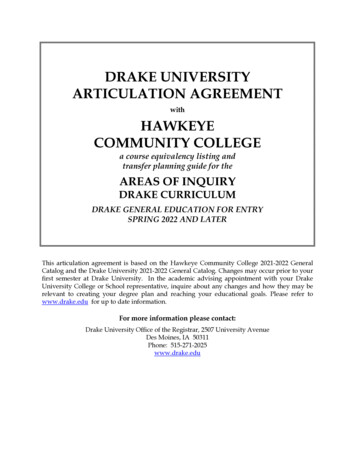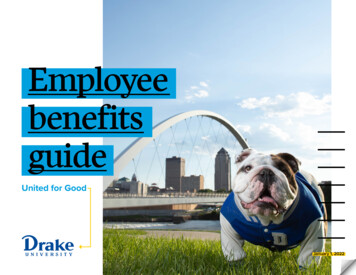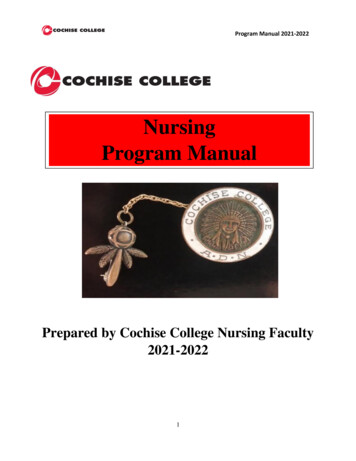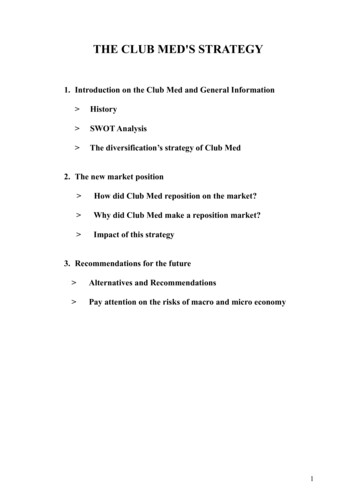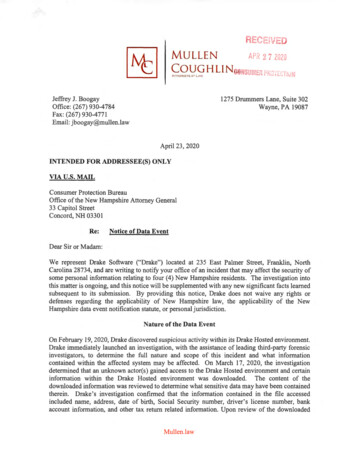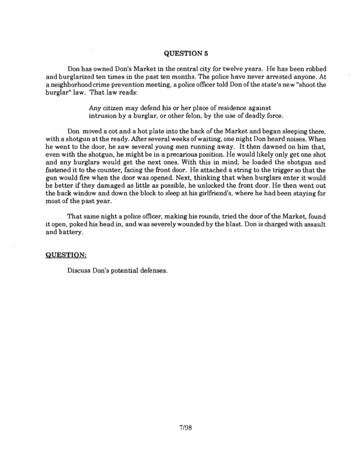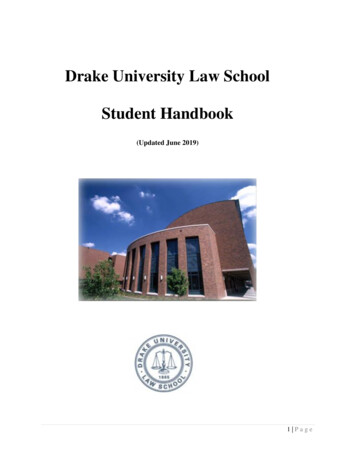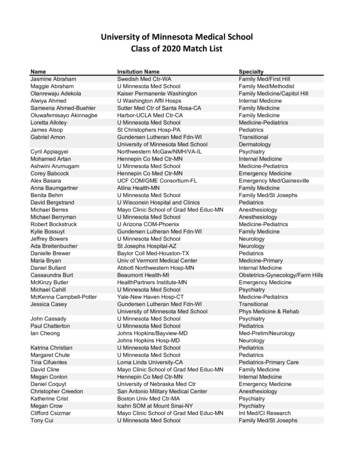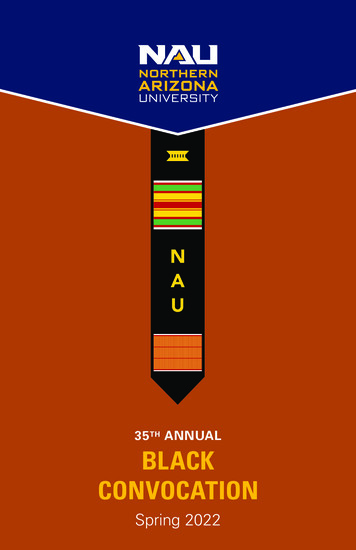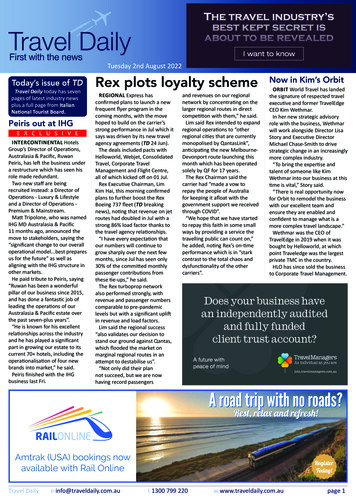
Transcription
Med-Com Career Training / Drake College of BusinessIntroductionMed-Com Career Training / Drake College of Business (“Drake”) is a closely held, for-profiteducation company that offers Certificate and 2-year degrees in allied health and information technologyfields. While private distributions to shareholders totaled 4.35 million in 2009, the company’s studentloan default rate was 40 percent for students entering repayment in 2008, the highest of all companiesthe committee examined. It is unclear whether the company delivers an educational product worth therapidly growing Federal investment taxpayers are making in the company.Company OverviewDrake is a privately held, for-profit education company headquartered in Elizabeth, NJ. Foundedin 1883 by William E. Drake as the Jersey City Business School, Drake originally provided professionaltraining for secretaries, accountants, and typists. Today, Drake has two campuses in New Jersey andoffers Certificate programs in medical office technology, dental assisting and Microsoft Officecertification. 2446Drake is nationally accredited by the Accrediting Council for Independent Colleges and Schools(ACICS) and is licensed by the New Jersey Departments of Education and Labor and WorkforceDevelopment. In 2010, ACICS launched an inquiry after reports emerged that Drake had been sendingrecruiters to local homeless shelters.2447In 2001, Drake was acquired by Med-Com Career Training, a privately held corporation. Thatsame year the current president of Drake, Ziad Fadel, assumed leadership of the company.2448Drake experienced modest enrollment growth between the fall of 2001 and the fall of 2009,growing from 280 students to 543 students. Since 2009, however, enrollment at Drake more thanquadrupled, with 2,592 students enrolled in fall 2010.2449 That represents a 1-year enrollment growth of400 percent, one of the largest posted single year enrollment increases of any company the committeeexamined.2450 This growth was largely due to opening a second campus in Newark, NJ.2446Elizabeth, NJ and Newark, NJ. Drake College of Business, Programs of Study, tudy (accessed July 8, 2012).2447See Kelly Heyboer and Bob Considine, “U.S. agency probes N.J.’s Drake College of Business for paying homelessstudents,” New Jersey Star-Ledger, May 5, 2010. http://www.nj.com/news/index.ssf/2010/05/drake college to stop recruiti.html (accessed June 21, 2012); see also, ACICS Correspondence, August 11, 2010 (DCBUS-SEN-00004161).2448See Drake College of Business, Organizational Charts and Structure, (HELP-DCB-000004 and HELP-DCB-000005).2449Enrollment is calculated using fall enrollment for all unit identifications controlled by the company for each year from theDepartment of Education’s Integrated Postsecondary Data System (hereinafter IPEDS). See Appendix 7.2450The most current enrollment data from the Department of Education measures enrollment in fall 2010. In 2011 and 2012,news accounts and SEC filings indicated that many for-profit education companies experienced a drop in new studentenrollment. This has also led to a decrease in revenue and profit at some companies.601
Enrollment at Med‐Com Career Training, Inc., 329Fall 2001Fall 2002Fall 2003461484512551543415Fall 2004Fall 2005Fall 2006Fall 2007Fall 2008Fall 2009‐Fall 2010Although Drake did not experience substantial enrollment growth between 2006 and 2009,Drake’s revenue increased more than 1,200 percent over that period, from 3.7 million in 2006 to 49.7million in 2009.2451 Revenue figures for 2010 are unavailable.Federal RevenueNearly all for-profit education companies derive the majority of revenues from Federal financialaid programs. Between 2001 and 2010, the share of title IV Federal financial aid funds flowing to forprofit colleges increased from 12.2 to 24.8 percent and from 5.4 to 32.2 billion.2452 Together, the 30companies the committee examined derived 79 percent of revenues from title IV Federal financial aidprograms in 2010, up from 69 percent in 2006.24532451Revenue figures for publicly traded companies are from Securities and Exchange Commission annual 10-K filings.Revenue figures for privately held companies are from the company financial statements produced to the committee. SeeAppendix 18.2452“Federal financial aid funds” as used in this report means funds made available through Title IV of the Higher EducationAct, including subsidized and unsubsidized Stafford loans, Pell grants, PLUS loans and multiple other small loan and grantprograms. See 20 USC §1070 et seq. Senate HELP Committee staff analysis of U.S. Department of Education, FederalStudent Aid Data Center, Title IV Program Volume Reports by programmatic.html (accessed July 12, 2012), 2000-1 and 2009-10. Figures for2000-1 calculated using data provided to the committee by the U.S. Department of Education.2453Senate HELP Committee staff analysis of Proprietary School 90/10 numerator and denominator figures for each OPEIDprovided to the U.S. Department of Education pursuant to section 487(d)(4) of the Higher Education Act of 1965. Data forfiscal year 2006 provided to the committee by each company; data for fiscal year 2010 provided by the Department ofEducation on October 14, 2011. See Appendix 9.602
In 2010, Drake reported 84.3 percent of revenue from title IV Federal financial aidprograms.2454 Of the 30 companies examined, Drake is the only company that does not collect additionalFederal dollars from Departments of Defense and Veterans Affairs military education benefitprograms.2455Med‐Com Career Training, Inc. Federal Money Share, 2010Federal EducationFunds: 33 Million15.7%84.3%Federal Education FundsNon‐Federal FundsThe Pell grant program, the most substantial Federal program to assist economicallydisadvantaged students with college costs, is a significant source of revenue for for-profit colleges.Over the past 10 years, the amount of Pell grant funds collected by for-profit colleges as a wholeincreased from 1.4 billion to 8.8 billion; the share of total Pell disbursements that for-profit collegescollected increased from 14 to 25 percent.2456 Part of the reason for this increase is that Congress hasrepeatedly increased the amount of Pell grant dollars available to a student over the past 4 years, and, forthe 2009-10 and 2010-11 academic years, allowed students attending year-round to receive two Pellawards in 1 year. Poor economic conditions have also played a role in increasing the number of Pelleligible students enrolling in for-profit colleges.2454Id.Id. The Ensuring Continued Access to Student Loan Act (ECASLA) increased Stafford loan amounts by up to 2,000 perstudent. The bill also allowed for-profit education companies to exclude the increased amounts of loan eligibility from thecalculation of Federal revenues (the 90/10 calculation) during fiscal years 2009 and 2010. However, ECASLA calculationsfor Med-Com could not be extrapolated from the data the company provided to the committee. “Federal education funds” asused in this report means Federal financial aid funds combined with estimated Federal funds received from Department ofDefense and Department of Veterans Affairs military education benefit programs. However, Drake did not collect any fundsfrom these programs. See Appendix 10.2456Senate HELP Committee staff analysis of U.S. Department of Education, Federal Student Aid Data Center, Title IV PellGrant Program Volume Reports by School, 2001-2 and /programmatic.html.2455603
Pell Funds Collected by Med‐Com Career Training, Inc.,Award Years 2007‐1018 1616 1314Dollars in Millions1210864 4 3202007200820092010Drake tripled the amount of Pell grants it collects just in the past 3 years, from 2.96 million in2007 to 15.8 million in 2010.2457 Department of Education data indicate that 100 percent of students atthe company’s Newark, NJ campus and 90 percent of students at the Elizabeth, NJ campus received Pellgrants in 2009-10.2458SpendingWhile the Federal student aid programs are intended to support educational opportunities forstudents, for-profit education companies direct much of revenues to marketing and recruiting newstudents and to profits. On average, among the 15 publicly traded education companies, 86 percent ofrevenues came from Federal taxpayers in fiscal year 2009.2459 During the same period the companiesspent 23 percent of revenues on marketing and recruiting ( 3.7 billion), and 19.7 percent on profit ( 3.2billion).24602457Pell disbursements are reported according to the Department of Education’s student aid “award year,” which runs fromJuly 1 through June 30 each year. Senate HELP Committee staff analysis of U.S. Department of Education, Federal StudentAid Data Center, Title IV Pell Grant Program Volume Reports by School, 2006-7 through /programmatic.html. See Appendix 13.2458IPEDS, Data Feedback Report, 2011.2459Senate HELP Committee staff analysis of fiscal year 2009 Proprietary School 90/10 numerator and denominator figuresplus all additional Federal revenues received in fiscal year 2009 provided to the committee by each company pursuant to thecommittee document request of August 5, 2010.2460Senate HELP Committee staff analysis of fiscal year 2009 financial statements and information provided to thecommittee by each company pursuant to the committee document request of August 5, 2010. Profit is based on operatingincome. Marketing and recruiting includes all spending on marketing, advertising, admissions and enrollment personnel as604
In 2009, Drake allocated 0.9 percent, or 465,816, to marketing and recruiting and 17.6 percent,or about 9 million, to profit. 2461 Out of its profit, Drake distributed 4.3 million to its small group ofshareholders.2462 In addition, Drake devoted 9.8 million to unclassified “consulting fees,” an additional20 percent of revenue.2463Spending at Med‐Com Career Training, Inc. as a Share of Revenue, 2009Marketing, 0.9%Profit, 17.6%Marketing: 466,000Profit: 8.7MillionOther, 81.5%Driven by a surge in enrollment, Drake also generated increasing profits. In 2009, Drakereported a profit of 8.7 million, 11 times more than its profit in 2006.2464 Private distributions of profitsto the company’s shareholders grew more than six times, from 604,622 in 2006 to 4.3 million in2009.2465reported to the committee. See Appendix 19. “Other” category includes administration, instruction, executive compensation,faculty salaries, student services, facilities, maintenance and bad debt expenses.2461Id. On average, the 30 for-profit schools examined spent 22.7 percent of revenue on marketing and 19.4 percent onprofit.2462Id.2463Harvey Glick, CPA, Med-Com Career Training, Inc. Audited Financial Statements, December 31, 2009 (HELPDCB 000006) [unredacted version on file with committee].2464Med-Com Career Training, Inc. Audited Financial Statements, 2006-9 [on file with committee]. See Appendix 18.2465Id.605
Med‐Com Career Training, Inc. Profit (Operating Income), 2006‐910 998Dollars in Millions7654 3321 1 120062007020082009Executive CompensationAs a privately held company, Drake is not obligated to release executive compensation figures.Tuition and Other Academic ChargesCompared to its public colleges offering the same programs, the price of tuition is moreexpensive at Drake. A Certificate in Dental Assisting at Drake costs 19,200,2466 whereas the sameCertificate at Newark’s Essex County College costs 5,853.24672466See Appendix 14; see also, Drake College of Business, Tuition, accessed April 2, 2012). Drake identifies this as the total cost of the program, including tuition, fees, books and supplies.2467See Appendix 14; see also, Essex County College, Essex County College, http://www.essex.edu/ (accessed June 21,2012).606
Cost of a Certificate in Dental Assisting at Drake College of Business andEssex County Community College 25,000 20,000 19,200 15,000 10,000 5,853 5,000 0Drake College of BusinessEssex County Community CollegeTuition at Drake has risen dramatically in recent years.2468 In 2006, the full cost for a Certificatein Dental Assisting was 4,375. Since that time, the company has increased tuition an average of twiceeach year to the current price of 19,200. In September 2008, Drake nearly doubled the cost of all of itsprograms.Through its raises in the price of tuition and enrollment growth, Drake has increased its revenuesmore than 1,200 percent since 2006. Additionally, a growing amount of this increase has been kept bythe company’s owners as profit.RecruitingEnrollment growth is critical to the business success of for-profit education companies. In orderto meet revenue and profit expectations, for-profit colleges must recruit as many students as possible tosign up for their programs.In 2010, Bloomberg BusinessWeek reported that Drake and other for-profit colleges weretargeting the homeless with high pressure recruiting tactics.2469 Beginning in 2008, Drake offeredpotential students a biweekly stipend of 350 for enrolling, attending class and maintaining their gradesabove a “C” average. At the time of the BusinessWeek article’s publication in early 2010, one source2468Drake College of Business, Program Costs for Each Program, January 1, 2010 (DCB-US-SEN-00000579, at DCB-USSEN-00000580-82).2469Daniel Golden, “The Homeless at College,” Business Week, April 30, 2010 http://www.businessweek.com/magazine/content/10 19/b4177064219731.htm (Accessed June 21, 2012).607
estimated that 3/4ths of the students enrolled at Drake were receiving the stipend.2470 Another sourceopined that many students would not have enrolled and would not continue to attend school without theincentive of the stipend. The company’s 2009 financial statement indicates that the company spent 11.8 million, 23.7 percent of its revenue, on “Student reimbursement expenses.” 2471Drake suspended its homeless recruiting efforts after questions were raised in 2010 after thepublication of the BusinessWeek article.2472 The company states that while the company no longer sendsemployees to shelters, it will still accept potential students who apply for admission who reside atshelters. Drake also changed the form of its stipend program.2473 Drake has continued to providestudents with 350 a week as a Line of Credit that will be forgiven if the student graduates on time witha GPA of 3.0 or higher.2474 If the student does not graduate on time with a GPA of 3.0 or higher, thecollege states that a student must pay back the Line of Credit at 0 percent interest over 20 years.2475Following the revelation of recruiting at homeless shelters and the payments to students, thecollege’s accreditor, ACICS, initiated an inquiry into its recruiting practices.2476 An ACICS team thatvisited Drake raised a number of “fundamental issues about the alignment of DCB [Drake] businesspractices and its Institutional Effectiveness Plan.” 2477 Among other things, the visiting team wasconcerned with whether and how the company was measuring the effectiveness of the Line of Creditpayments. The company states that all issues were fully resolved with the accrediting agency and thatthe agency determined that Drake demonstrated full compliance with accrediting standards.OutcomesWhile aggressive recruiting and high cost programs might be less problematic if students werereceiving promised educational outcomes, committee staff analysis showed that tremendous numbers ofstudents are leaving for-profit colleges without a degree. Because 98 percent of students who enroll in a2-year degree program at a for-profit college, and 96 percent who enroll in a 4-year degree program,take out loans, hundreds of thousands of students are leaving for-profit colleges with debt but nodiploma or degree each year.2478Two metrics are key to assessing student outcomes: (1) retention rates based on informationprovided to the committee, and (2) student loan “cohort default rates.” An analysis of these metricsindicates that many people who enroll in at Drake are not achieving their educational and career goals.2470Id.Harvey Glick, CPA, Med-Com Career Training, Inc. Audited Financial Statements, December 31, 2009 (HELPDCB 000006) [unredacted version on file with committee].2472Kelly Heyboer and Bob Considine, “U.S. agency probes N.J.’s Drake College of Business for paying homeless students,”New Jersey Star-Ledger, May 5, 2010. http://www.nj.com/news/index.ssf/2010/05/ drake college to stop recruiti.html(accessed June 21, 2012).2473Id.; ACICS Correspondence, August 11, 2010 (DCB-US-SEN-00004161).2474Drake College of Business, Promissory Installment Note, (DCB-US-SEN-00000626, at DCB-US-SEN-00000638).2475Id., at DCB-US-SEN-00000642.2476ACICS Correspondence, August 11, 2010 (DCB-US-SEN-00004161).2477Id.2478Patricia Steele and Sandy Baum, “How Much Are College Students Borrowing?,” College Board Policy Brief, August2009 es/09b 552 PolicyBrief WEB 090730.pdf (accessed June 22, 2012).2471608
Retention RatesRetention data Drake provided information to the committee appears to be incorrect. Aspreadsheet provided by the company indicates that 6,261 students enrolled at Drake in 2008-9.2479According to information the company provided to the Department of Education, the company’s totalenrollment in fall 2009 was 543 students, a dramatic difference between the data the company providedto the committee.Department of Education data shows that the graduation rate of first-time full-time students atthe company’s Elizabeth, NJ campus is 30 percent, and the rate at the Newark, NJ campus is unavailablebecause the campus is new.2480Student Loan DefaultsThe Department of Education tracks and reports the number of students who default on studentloans (meaning that the student does not make payments for at least 360 days) within 3 years of enteringrepayment, which usually begins 6 months after leaving college.2481Slightly more than 1 in 5 students who attended a for-profit college (22 percent) defaulted on astudent loan, according to the most recent data.2482 In contrast, 1 student in 11 at public and non-profitschools defaulted within the same period.2483 On the whole, students who attended for-profit schoolsdefault at nearly three times the rate of students who attended other types of institutions.2484 Theconsequence of this higher rate is that almost half of all student loans defaults nationwide are held bystudents who attended for-profit colleges.2485The default rate across all 30 companies examined increased each fiscal year between 2005 and2008, from 17.1 percent to 22.6 percent.2486 This change represents a 32.6 percent increase over 4years.2487 While Drake’s default rate fell between students entering repayment in 2006 and 2007, its2008 default rate skyrocketed, more than doubling from 17.9 percent for students entering repayment in2007 to 40.1 percent for students entering repayment in 2008.2488 Drake’s 2008 default rate is almostdouble the rate for all for-profit colleges and more than triple the rate for colleges in all sectors and hasthe highest rate of loan default among the 30 schools the committee examined.2479Senate HELP Committee staff analysis. See Appendix 15.IPEDS, 2010 Graduation Rate.2481Direct Loan Default Rates, 34 CFR 668.183(c).2482Senate HELP Committee staff analysis of U.S. Department of Education Trial Cohort Default Rates fiscal year cohort.html. Default rates calculated by cumulating number of students enteredinto repayment and default by sector.2483Id.2484Id.2485Id.2486Senate HELP Committee staff analysis of U.S. Department of Education Trial Cohort Default Rates fiscal year cohort.html. Default rates calculated by cumulating number of students enteredinto repayment and default for all OPEID numbers controlled by the company in each fiscal year. See Appendix 16.2487Id.2488Id.2480609
45%Med‐Com Career Training, Inc. Trial 3‐Year Default Rate, %2007200810%9.2%5%0%2006Med‐Com Career Training, Inc. Default RateAverage Default Rate, All SchoolsInstruction and AcademicsThe quality of any college’s academics is difficult to measure, however the amount that a schoolspends on instruction per student compared to other spending is a useful indicator. By looking at theinstructional cost that all sectors of higher education report to the Department of Education, it is possibleto compare spending on actual instruction.It is difficult to obtain a clear picture of the amount that Drake spends on instruction because thecompany misreported its instructional spending number to the Department of Education for 2009: Thecompany listed that it spent an amount equal to its entire operating expenditures on instruction, when infact the company’s financial statements show that a significant portion of their expenses were dedicatedto non-educational line items. For 2008, when it appears Drake reported a correct number, the companyspent 889 per student on instruction.2489 In contrast, public and non-profit schools, generally spend ahigher amount per student on instruction. Other New Jersey-based colleges spent, on a per studentbasis, 16,654 at Rutgers and 3,878 at Essex County Community College. 24902489Senate HELP Committee staff analysis. IPEDs data for instruction spending based on instructional cost provided by thecompany to the Department of Education. According to IPEDS, instruction cost is composed of “general academicinstruction, occupational and vocational instruction, special session instruction, community education, preparatory and adultbasic education, and remedial and tutorial instruction conducted by the teaching faculty for the institution’s students.”2490Senate HELP Committee staff analysis. See Appendix 23. Many for-profit colleges enroll a significant number ofstudents in online programs. In some cases, the lower delivery costs of online classes – which do not include construction,leasing and maintenance of physical buildings – are not passed on to students, who pay the same or higher tuition for onlinecourses.610
Drake spent 186 on marketing and 3,488 on profit per student in 2009.2491 The company alsospent 3,920 per student on unclassified “Consulting fees.”StaffingThe committee found that while for-profit education companies employed large numbers ofrecruiters to enroll new students, the companies had far less staff to provide tutoring, remedial servicesor career counseling and placement. In 2010, with 2,692 students, Drake employed 13 recruiters, 11career services employees, and 10 student services employees.2492 That means each career counselor wasresponsible for 245 students and each student services staffer was responsible for 269 students.Meanwhile, the company employed one recruiter for every 207 students.Med‐Com Career Training, Inc. Staffing, 2007‐10303,000252,500202,0001513 Recruiters101,5001,000551512Number of StudentsNumber of ing2008Student Services2009Career ServicesWhile overall there is not a large disparity in the number of recruiting and student and careerservice staff Drake employs, the number of student and career services staff remained constant asenrollment surged at Drake. Information provided by the company indicates that Drake hired noadditional student services staff and only one additional career services employee between 2009 and2010, even though the college’s enrollment increased nearly 400 percent over that period.ConclusionDrake is a small but highly profitable education company. Nearly all of Drake’s revenue isderived from Federal taxpayer funds, and most of the company’s profit is funneled to the company’s2491For this calculation, the committee relied on the instruction amount Drake reported in its financial statement rather thanthe number the company reported to IPEDS. The amount reported to IPEDS is incorrect. See Appendix 20 and Appendix22.2492Senate HELP Committee staff analysis of information provided to the committee by the company pursuant to thecommittee document request of August 5, 2010. See Appendix 7 and Appendix 24.611
small group of shareholders. Moreover, Drake increased its tuition tremendously over the past fewyears; its Certificate program tuition is approximately three times higher than tuition at nearbycommunity colleges.The company’s enrollment growth nearly quadrupled in a single year between 2009 and 2010.With this growth in enrollment, the amount of Federal financial aid dollars flowing to the school alsoincreased. And yet, a staggering share Drake students, more that 40 percent of those who enteredrepayment in 2008, were unable to make payments on their student loans and fell into default within 3years of leaving the school. These alarming outcomes are particularly troubling because they indicatethat students, some of whom Drake admitted recruiting from homeless shelters, are left with highamounts of debt and without the earning capacity necessary to pay for the cost of their education. Takentogether, these issues cast serious doubt on the notion that Drake’s students are receiving an educationthat affords them adequate value relative to the cost, and call into question the 33 million investmentAmerican taxpayers made in the company in 2010.612
604 Drake tripled the amount of Pell grants it collects just in the past 3 years, from 2.96 million in 2007 to 15.8 million in 2010.2457 Department of Education data indicate that 100 percent of students at the company's Newark, NJ campus and 90 percent of students at the Elizabeth, NJ campus received Pell
